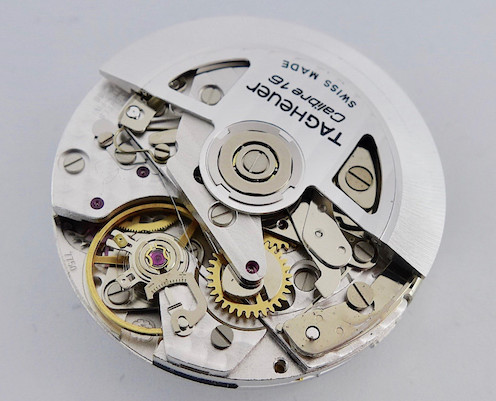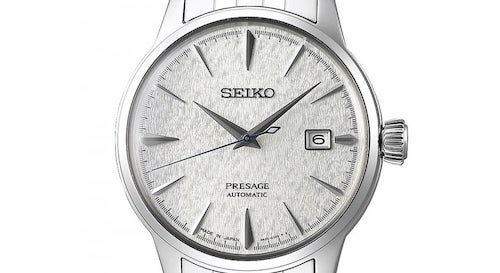When looking for a new watch, you will need to settle this question: Quartz vs automatic movement: which is better for me?
Quartz watches are suitable to those looking for high accurate timing, ease of maintenance and care. Automatic watches are suitable to those looking for smooth second hand sweep, and enjoys the intricacy and tradition of an automatic movement.

Before Automatic and Quartz
Earlier watches run on mechanical movement.
These mechanical watches require manual hand winding to wind up the spring. The power from the spring then moves the watch hands.
If you notice, many old grandfather clocks require manual winding. So do many vintage watches and many models of classic pocket watches.
How Does The Automatic Watch Work?
Lets start the Quartz vs automatic debate by looking into automatic movements first.
In 1821, Swiss watchmaker Jean-Pierre Perrelet invented the first self-winding watch.
This model used a rotor that turned as the wearer moved their arm. As the rotor turns, it winds the mainspring. Automatic watch technology was later further improved and made more reliable.
However, automatic watches have since been considered a mature technology. This means it may no longer be developed further on its own.
Are Automatic Watches Accurate?
Automatic watches are accurate within a few seconds per day. However, automatic watches need regular servicing to maintain their accuracy, as it has many moving parts.
Any weakness on the moving parts will affect the watch’s performance. For example, a worn-out gear, or dried lubricant.
When servicing an automatic watch, a watchmaker will check the watch’s accuracy by measuring it using a timegrapher.

What is the most reliable automatic watch movement?
There are many contenders for the most reliable automatic watch movement. However, Japan and Switzerland top the list.
The Miyota 8215, Seiko’s 4R35, the Sellita SW200, and the ETA 2824 have proven themselves to be very reliable watch movements.
If you are looking for an automatic watch movement that will last, then one of these four would be a great choice.
However, it does not mean other movements are not reliable.

There are plenty more movements that are just as good. The Valjoux 7750 for example, powers many Swiss chronograph watches. Orient’s F6222 movement is also strong and accurate.
In fact, many popular household or luxury watchmakers have their own proprietary movements, which have also proven to be very reliable and robust.
Automatic Movement: Pros
There are several advantages to automatic watches.
First, they do not require a battery, so you never have to worry about replacing it.
Second, they are powered by the movement of your wrist. This means that it will continue to run without stopping as long as you wear the watch.
Third, automatic watches are generally more accurate than quartz watches.
Finally, many people believe that automatic watches are more stylish and luxurious. This makes sense since most premium and expensive watches come with automatic movement.
The luxurious feeling often comes from hearing the constant ticking sound of the watch and seeing the sweeping second hand.
Automatic Movement: Cons
Automatic movements, however, do have their weak points.
First, as they are powered by kinetic energy, you have to keep winding it, or they will stop working.
That means you will need to wear them every day. If not, you will need a watch winder to keep your watch wound.
Secondly, automatic watches tend to be more expensive than watches with quartz movements.
There are more parts in an automatic watch, which means a higher production cost. This translates into a higher price tag.
Automatic watches also require more maintenance. Unlike quartz watches that generally require occasional battery change, automatic watches need to be serviced by a watchmaker.
The watchmaker will take the parts out, clean them, and reassemble the watch, adding some lubricant to smoothen the watch movement.
History of Quartz Movements
Lets carry the Quartz vs automatic debate further by looking into Quartz movement.
Quartz watches were first developed in the 1960s by Swiss engineers.
But it was the Japanese that managed to package the movement into a consumer product. In 1969, Seiko released the world’s first Quartz watch, the Seiko QuartzAstron 35SQ.

People soon realized the ease and affordability of Quartz watches. As a result, many started wearing Quartz watches.
Mass exodus from automatic watches caused many Swiss companies to suffer and struggle to survive. This period is known as the Quartz Crisis.
Traditional watchmakers have to decide: move up the value chain and become luxury brands or ‘cheapen’ themselves and produce cheap, plastic quartz watches.
Swatch, for example, was a successful case of how the Swiss watch industry tried to produce ‘cheap and fun’ quartz watches to compete with Japanese watches.
Quartz movement still powers many cheaper watches in the market due to its low cost of production.
How Does Quartz Movement Work?
Quartz watches use a battery to power a small quartz crystal. The crystal then vibrates at a very high frequency. The vibration helps to move the watch’s hands.
Quartz watches are also very affordable, as they are easier to assemble. They are also much more accurate than mechanical watches, with an accuracy of around +/- 15 seconds per month.
Quartz watches, however, require battery replacement. This usually happens once a few years.
More modern hybrid-quartz movements have solved this problem, however, by using either light or self-winding rotors.
What is the most accurate quartz watch movement?
The most accurate Quartz watches come from Japan and Switzerland. Some of the best Quartz watches on the market come from brands like Seiko, Citizen, and Orient.
In Switzerland, Ronda manufactures a great array of Quartz movements as well. Bulova also has a reputation for hyper-accurate Quartz movement with the Precisionist.
Quartz Movement: Pros
Quartz movements are more accurate than automatic movement over long periods.
This is because, in quartz movement, there are fewer parts. Since everything is electronic, there are fewer parts that may influence the movement’s reliability.
Quartz movement also does not need winding. Unlike automatic watches, Quartz watches get their power from batteries.
That means they do not need spring to power the movement, like in automatic watches.
This removed the need to have a watch winder or the need to wear the watch every day. The watch will run itself until the battery runs out.
With proper care, quartz watches also tend to last longer than automatic watches.
With proper care, it is common to see that quartz watches lasting 20-30 years with minimal maintenance.
Quartz watches usually only require battery changes. On top of that, it might be good check the condition of the water gaskets.
A tight water gasket ensures little moisture can go into the movement. Too much moisture can corrode or cause deterioration on the circuit board in the movement.
The ultimate strength of Quartz movements, however, is its price. They are simpler to manufacture and assemble as they have fewer parts.
This means lower costs. As a result, Quartz watches can be really cheap.
Quartz Movement: Cons
Quartz movement does have its weakness, however.
Firstly, Quartz watches need battery power. Without it, it will stop running.
This might require a trip to the watchmaker. However, this happens after a long duration. It is normal to see a single battery run for years in a Quartz watch.
Another downside of Quartz movement is their perceived cheapness.
Compared to automatic movements, quartz watches do not feel luxurious and premium.
There is no sweeping second hand. Instead of a frequent ticking sound in automatic watches, Quartz watches only ticks once a second.
Watchmakers also contributed to this sentiment. If you notice, most luxury watches come in automatic movements only.
How To Tell The Difference Between Quartz and Automatic Watches?
The easiest way to tell the difference is by reading the watch’s face.
For example, you can tell that this Seiko Presage has an automatic movement. The word ‘Automatic’ is printed on the dial.

If there is none, you can also look at the back of the watch.
Automatic watches like to show the movement by using a transparent case back. Quartz watches usually don’t. The case back might also show information. It might help you to tell the movement type.
Also, you can try observing the second hand.
Automatic movements tend to have a sweeping second hand motion, which means the hand seem to be moving forward all the time.
Meanwhile, Quartz watches ‘ticks’. The second hand jumps forward every one second.
Another way is to hear the watch up close. Simply take the watch and put it right to your ear.
If you hear a constant ticking sound, the watch is more than likely an automatic. However, if you hear only a tick every second, then watch is probably a Quartz.
However, with the advent of hybrid movements, things may no longer be this straightforward.
When in doubt, always check the watch model at the watchmaker’s website, to confirm the movement type.
Are there any Other Movements?
In recent times, there are more than just Quartz vs automatic movements.
Watchmakers have been trying to bring the best of Quartz and automatic technology together. This resulted in hybrid movements.
Watchmakers also try to further improve Quartz movement. This is because their electronic architecture provides more opportunities for improvement.
The Automatic Quartz
As their name says, Automatic Quartz combines automatic and Quartz technology.
In simple terms, automatic quartz movement uses a self-winding rotor mechanism used in automatic watches.
In a usual automatic watch, the self-winding rotor will wind a spring. The spring will then power and move the watch’s hands.
But in automatic Quartz, the rotor will instead electric power to vibrate a piezoelectric quartz crystal. The vibration of the crystal will then move the watch’s hands.
Therefore, in an automatic Quartz movement, you get the advantage of Quartz’s accuracy and reliability. And you discard the inconvenience and environmental impact of batteries.
Seiko Kinetic line of watches runs automatic quartz movement. Some Grand Seiko watches also use a variant of the Automatic Quartz technology, called the Seiko Spring Drive.
In Switzerland, ETA also manufactures automatic Quartz movements called AutoQuartz.
ETA’s AutoQuartz has since found its way into many Swiss watches. For example Omega, Tissot, Longines, Fortis, Franck Muller, and Cyma.
Citizen also manufactures their own version of automatic quartz movements. They called it the Eco-Drive Duo.
Solar Quartz
Watchmakers also tried to improve the quartz movement by powering it using light.

Citizen Eco-Drive is a fine example of such a movement. Light is used to power Eco-Drive. The light source can be natural (sun), or artificial (lamp).
The energy generated will vibrate a quartz crystal, moving the watch hand.
That means your Quartz watch can run without a battery, as all it needs are either the sun or lights from lamps.
This means good news for the environment. In fact, the Eco-Drive movement has helped to reduce the usage of 10 million batteries in North America alone.
Casio, Seiko, Bulova, and many other watchmakers also have released their lines of solar watches.
Quartz vs Automatic watches, Who Wins?
So who wins in the battle of Quartz vs automatic watches? Ultimately, it comes down to personal preference.
Go with Quartz if you want a consistently accurate watch and if you are too lazy to wind your watch.
If you want a more reliable watch that doesn’t require batteries, go with an automatic watch.
Whichever one you choose, you can’t go wrong!

